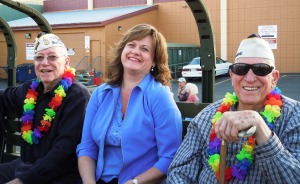Sightseeing is thirsty business. After exploring the Christmas Story House and the Rock and Roll Hall of Fame in Cleveland last month, we stopped for refreshment at the Tremont Tap House.
Our friendly server asked where we were from and when I said Washington, she asked, “The one by Canada?”
Once we were clear on geography and had our beverages, she asked if we’d be in Cleveland for Dyngus Day.
Now, when I was a kid “dingus” was synonymous with dingbat, dumbbell, doofus, and other not so nice words. Who knew there was a special day set aside to celebrate the dim bulbs among us?
Our waitress quickly disabused me of that notion.
“Dyngus Day is also called Wet Monday,” she explained. “It’s the day after Easter. There’s a parade and polkas and pierogis.”
She grabbed a guidebook off the counter.
“You can read all about it,” she said. “It’s a hoot. We throw water on each other and hit people with pussy willow branches.”
I love a good polka as much as anyone, but having water thrown on me, and being smacked by shrubbery isn’t what I consider a “hoot.”
Alas, I didn’t have opportunity to experience the delight of Dyngus because we flew home just before the holiday.
My curiosity was piqued, though, so this weekend I sat down and perused the booklet describing Cleveland’s biggest polka party. And then I delved deeper into the Dyngus.
First of all we were wrong to use the word as a childhood slur because loosely translated it actually means worthy, proper or suitable.
Historically a Polish tradition, Dyngus Day celebrates the end of the observance of Lent and the joy of Easter. It dates back to the baptism of Prince Mieszko I on Easter Monday in 966 A.D. The water symbolized purification, hence “Wet Monday.”
Cleveland is just one of many cities throughout the U.S. that hosts parties and parades in honor of Easter Monday. The largest celebration is in Buffalo, New York, where a local paper once proclaimed, “Everybody is Polish on Dyngus Day!”
Traditions abound, including wearing red and white, the colors of the Polish flag. But perhaps the most well-known Dyngus Day tradition is that in which single boys try to splash water on single girls as an expression of interest. Rooting from the baptism of the prince, the water represents cleansing, purification and fertility.
Men and women can also flirt with pussy willows, which are among the first plants to bud in the spring. The young men may lightly hit women on their legs to show they are interested.
That’s why my Cleveland guide lists the following as Dyngus Day essential items; pussy willows, squirt guns and polka pants.
Apparently, squirt gun fights and pussy willow whacks add up to a really good time.
Not everyone has been a fan of the celebration. The Bishop of Pozan’ tried to derail Dyngus Day in 1410. He forbade it, instructing residents not to “pester or plague others in what is universally called Dingus.”
Obviously, the prohibition didn’t stick. Probably because other activities include sampling Polish foods like pierogis, kielbasa and stuffed cabbage and drinking pints of piwo (beer).
Polka music is the heart and soul of the party, which means roving accordion bands and plenty of room for dancing.
In Cleveland the celebration culminates with the crowning of Miss Dyngus Day, followed by a parade featuring the “Frankie Yankovic accordion head float.”
I cannot believe we missed an ACCORDION HEAD FLOAT.
Which leaves me to wonder if Spokane has a large enough Polish community to pull of our own party and parade?
In any case, I’ve already planned our next trip to Ohio. I’m practicing my polka because we’ll be back on April 29, 2019 – Dyngus Day.
Contact Cindy Hval at dchval@juno.com. She is the author of “War Bonds: Love Stories From the Greatest Generation.” Follow her on Twitter at @CindyHval.


